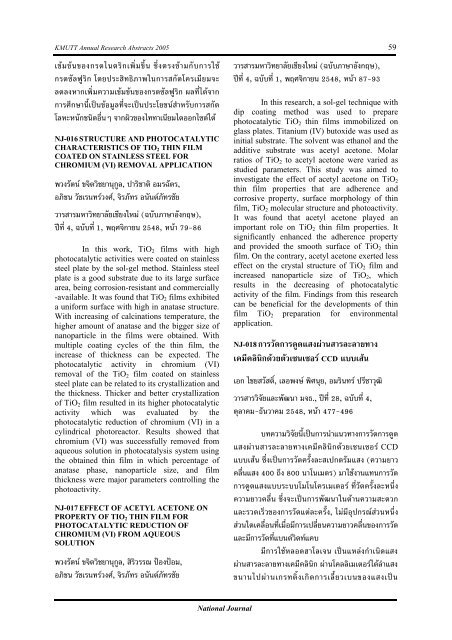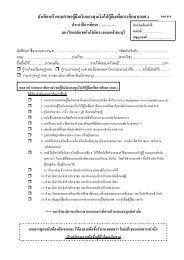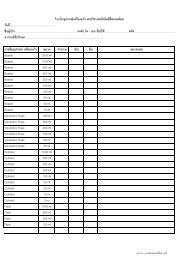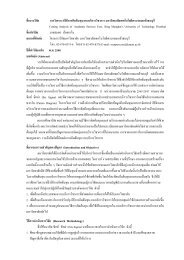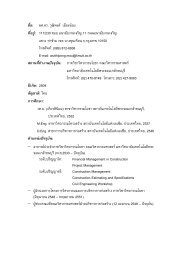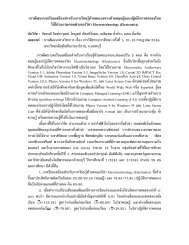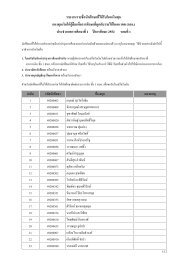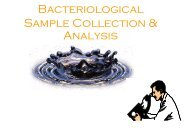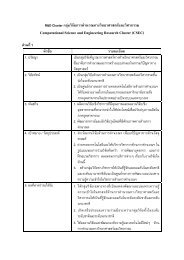Create successful ePaper yourself
Turn your PDF publications into a flip-book with our unique Google optimized e-Paper software.
KMUTT Annual Research Abstracts 2005<br />
เขมขนของกรดไนตริกเพิ่มขึ้น ซึ่งตรงขามกับการใช<br />
กรดซัลฟูริก โดยประสิทธิภาพในการสกัดโครเมียมจะ<br />
ลดลงหากเพิ่มความเขมขนของกรดซัลฟูริก ผลที่ไดจาก<br />
การศึกษานี้เปนขอมูลที่จะเปนประโยชนสําหรับการสกัด<br />
โลหะหนักชนิดอื่นๆ จากผิวของไททาเนียมไดออกไซดได<br />
NJ-016 STRUCTURE AND PHOTOCATALYTIC<br />
CHARACTERISTICS OF TIO 2 THIN FILM<br />
COATED ON STAINLESS STEEL FOR<br />
CHROMIUM (VI) REMOVAL APPLICATION<br />
พวงรัตน ขจิตวิชยานุกูล, ปาริชาติ อมรฉัตร,<br />
อภิชน วัชเรนทรวงศ, จิรภัทร อนันตภัทรชัย<br />
วารสารมหาวิทยาลัยเชียงใหม (ฉบับภาษาอังกฤษ),<br />
ปที่ 4, ฉบับที่ 1, พฤศจิกายน 2548, หนา 79-86<br />
In this work, TiO 2 films with high<br />
photocatalytic activities were coated on stainless<br />
steel plate by the sol-gel method. Stainless steel<br />
plate is a good substrate due to its large surface<br />
area, being corrosion-resistant and commercially<br />
-available. It was found that TiO 2 films exhibited<br />
a uniform surface with high in anatase structure.<br />
With increasing of calcinations temperature, the<br />
higher amount of anatase and the bigger size of<br />
nanoparticle in the films were obtained. With<br />
multiple coating cycles of the thin film, the<br />
increase of thickness can be expected. The<br />
photocatalytic activity in chromium (VI)<br />
removal of the TiO 2 film coated on stainless<br />
steel plate can be related to its crystallization and<br />
the thickness. Thicker and better crystallization<br />
of TiO 2 film resulted in its higher photocatalytic<br />
activity which was evaluated by the<br />
photocatalytic reduction of chromium (VI) in a<br />
cylindrical photoreactor. Results showed that<br />
chromium (VI) was successfully removed from<br />
aqueous solution in photocatalysis system using<br />
the obtained thin film in which percentage of<br />
anatase phase, nanoparticle size, and film<br />
thickness were major parameters controlling the<br />
photoactivity.<br />
NJ-017 EFFECT OF ACETYL ACETONE ON<br />
PROPERTY OF TIO 2 THIN FILM FOR<br />
PHOTOCATALYTIC REDUCTION OF<br />
CHROMIUM (VI) FROM AQUEOUS<br />
SOLUTION<br />
พวงรัตน ขจิตวิชยานุกูล, สิริวรรณ ปองปอม,<br />
อภิชน วัชเรนทรวงศ, จิรภัทร อนันตภัทรชัย<br />
วารสารมหาวิทยาลัยเชียงใหม (ฉบับภาษาอังกฤษ),<br />
ปที่ 4, ฉบับที่ 1, พฤศจิกายน 2548, หนา 87-93<br />
In this research, a sol-gel technique with<br />
dip coating method was used to prepare<br />
photocatalytic TiO 2 thin films immobilized on<br />
glass plates. Titanium (IV) butoxide was used as<br />
initial substrate. The solvent was ethanol and the<br />
additive substrate was acetyl acetone. Molar<br />
ratios of TiO 2 to acetyl acetone were varied as<br />
studied parameters. This study was aimed to<br />
investigate the effect of acetyl acetone on TiO 2<br />
thin film properties that are adherence and<br />
corrosive property, surface morphology of thin<br />
film, TiO 2 molecular structure and photoactivity.<br />
It was found that acetyl acetone played an<br />
important role on TiO 2 thin film properties. It<br />
significantly enhanced the adherence property<br />
and provided the smooth surface of TiO 2 thin<br />
film. On the contrary, acetyl acetone exerted less<br />
effect on the crystal structure of TiO 2 film and<br />
increased nanoparticle size of TiO 2 , which<br />
results in the decreasing of photocatalytic<br />
activity of the film. Findings from this research<br />
can be beneficial for the developments of thin<br />
film TiO 2 preparation for environmental<br />
application.<br />
NJ-018 การวัดการดูดแสงผานสารละลายทาง<br />
เคมีคลินิกดวยตัวเซนเซอร CCD แบบเสน<br />
เอก ไชยสวัสดิ์, เลอพงษ พิศนุย, อมรินทร ปรีชาวุฒิ<br />
วารสารวิจัยและพัฒนา มจธ., ปที่ 28, ฉบับที่ 4,<br />
ตุลาคม-ธันวาคม 2548, หนา 477-496<br />
บทความวิจัยนี้เปนการนําแนวทางการวัดการดูด<br />
แสงผานสารละลายทางเคมีคลินิกดวยเซนเซอร CCD<br />
แบบเสน ซึ่งเปนการวัดครั้งละสเปกตรัมแสง (ความยาว<br />
คลื่นแสง 400 ถึง 800 นาโนเมตร) มาใชงานแทนการวัด<br />
การดูดแสงแบบระบบโมโนโครเมเตอร ที่วัดครั้งละหนึ่ง<br />
ความยาวคลื่น ซึ่งจะเปนการพัฒนาในดานความสะดวก<br />
และรวดเร็วของการวัดแตละครั้ง, ไมมีอุปกรณสวนหนึ่ง<br />
สวนใดเคลื่อนที่เมื่อมีการเปลี่ยนความยาวคลื่นของการวัด<br />
และมีการวัดที่แบนดวิดทแคบ<br />
มีการใชหลอดฮาโลเจน เปนแหลงกําเนิดแสง<br />
ผานสารละลายทางเคมีคลินิก ผานโคลลิเมเตอรไดลําแสง<br />
ขนานไปผานเกรทติ้งเกิดการเลี้ยวเบนของแสงเปน<br />
59<br />
National Journal


